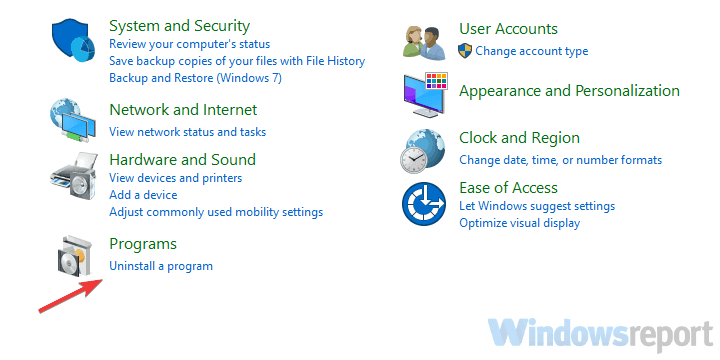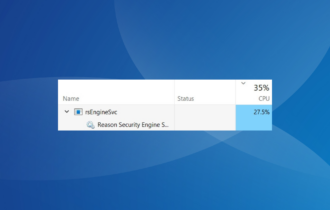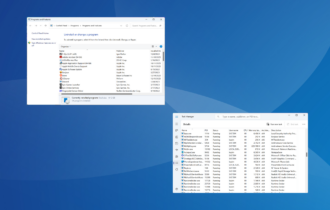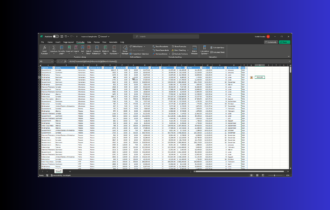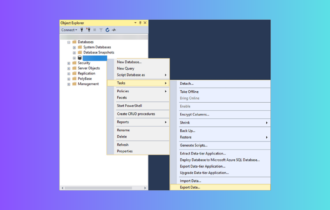Excel High CPU Usage: Why & How to Limit It
Tweak your settings and fix corruption in just a few simple steps
6 min. read
Updated on
Read our disclosure page to find out how can you help Windows Report sustain the editorial team Read more
Key notes
- Microsoft Excel is the most popular and most powerful spreadsheet software available.
- It comes included in the Microsoft Office package and is an amazing productivity tool
- If your CPU usage is high while using Excel, there are a few things that we explore.
- Find below how you can repair the app, open it in safe mode, and more.

Microsoft Office is and always will be the go-to office suite for the majority of Microsoft users. It’s reliable and the interface used in the Office defined how text processors and spreadsheet editors look today.
However, even the most sturdy native applications have had certain issues in the Windows platform. One of the most peculiar concerns is high CPU usage in Excel.
We made sure to enlist some applicable solutions below and help you address this as soon as possible.
? Why is Excel using so much CPU?
High CPU usage in Excel doesn’t have a single cause and can occur in different actions.
Generally, an app uses more resources if it’s out of date or it has been in use for a very long time. Consider updating Excel and restarting your device.
Some users complain that Excel is not responding when it has high CPU usage, others noticed high CPU usage when copying or saving, or even when Excel is idle.
So you depending on what exactly you’re experiencing, you may have to tackle the issue differently, but we got plenty of options for you.
⛔How do I limit CPU usage in Excel?
The app seems to respond badly and to use a higher CPU on certain tasks, so you can consider limiting the simultaneous tasks and disabling unnecessary add-ons.
If you’re encountering high CPU usage on a specific Excel file, but others work fine, it’s possible that it’s corrupted.
Learn below how to fix it, plus other nifty methods that will help you fix Excel’s high CPU usage when idle or working.
How can I Fix the high CPU usage caused by Microsoft Excel?
1. Update Office
Let’s start by updating the Office suite. As you probably know, all updates for Office come via Windows Updates.
Most of them are security patches and minor fixes, but Microsoft usually addresses a major issue when it occurs. And this high CPU usage caused by Excel is certainly a widespread problem.
Also, try running the application as admin. Here’s how to grant administrative permissions to Excel:
- Right-click on the Excel shortcut and open Properties.
- Choose the Compatibility tab.
- Check the Run this program as an administrator box and confirm changes.
2. Try using Excel in Safe mode and disable Add-ins
➡️ Here’s how to run Safe mode in Excel:
- Press and hold the CTRL and double-click on the Excel shortcut to run it in Safe mode.
- If there are performance improvements, remove Add-ins to fix the error.
- Also, try removing recent formulas.
Another way to troubleshoot high CPU usage caused by Excel is to run it in Safe mode. With that, you’ll learn about the possible impact certain add-in or COM has on the application execution.
If the CPU usage drops while in Safe mode, we suggest disabling Add-ins one by one with the system of elimination until you find out which one is causing the issue.
3. Delete local files
- Make sure Excel is fully closed.
- Navigate to
C:UsersYour UsernameAppDataRoamingMicrosoftExcel. - Open the Excel folder and copy the whole content of the folder. Paste it somewhere else to back it up.
- Delete everything from the Excel folder.
- Restart your PC and try using Excel again.
Besides the repair, which should resolve the high CPU usage in Excel on its own, a manual approach might be a better choice.
If there’s a problem with Excel formulas or configuration, deleting configuration files might plummet the high CPU usage. After you delete them, everything should return to normal.
4. Repair damaged Excel file
A high CPU usage might tell you that there are certain errors that will eventually lead to a damaged or corrupt spreadsheet.
A symptom of this issue is that the Excel sheet freezes and the task has high CPU usage.
This means that eventually, you will not be able to open the file and read the contents anymore. Luckily, there are 3rd party utilities to assist with the repair process.
 Tip
Tip
This highly praised tool works with all versions of Windows starting from the latest version of Windows 10 and up until the very old Windows XP.
It is also compatible with Microsoft Excel 2019, 2016, and all the way down to Excel 2000 version. If it’s compatible it means it can perform the necessary operations to repair one or more files and fix Excel causing high CPU usage.
All you need to do is close all Excel files and quit the app. Start the Stellar program, select the file that is causing you trouble, and hit the Repair button.
When the process is finished, a summary screen will be shown, and also a preview of the content will be available. You will then be able to choose where to save the new, repaired file.
Proceed to open this new file with Excel and check if the CPU problem is gone.
5. Repair Excel
- In the Windows Search bar, type Control and open Control Panel.
- Open Uninstall a program under the Programs section.
- Locate Office, right-click on it, and choose Repair.
- Wait until the installation is repaired and restart your PC.
Another viable solution in case the Excel installation got corrupt is to repair it. This precedes the reinstallation since you at least get to do it with the system resources.
After you repair the installation, the problem should be resolved. Have in mind that this isn’t as successful as the clean reinstall is, but it’s still worth a try.
The steps that show you how to repair Excel are shown above.
If this wasn’t helpful, we suggest moving onwards with the steps below.
6. Disable third-party applications
- In the Windows Search bar, type msconfig and open System Configuration.
- Under the Services tab, check the Hide all Microsoft services box.
- Click Disable all to disable all active third-party services.
- Now, select the Startup tab and go to Task Manager.
- Prevent all programs from starting with the system and confirm changes.
- Restart your PC.
Another possible reason for this kind of unusual behavior might be found in the background activity of certain third-party apps.
Some of them won’t affect the execution of Excel, while others can. The most common issues occur due to a third-party antivirus, but there are some other third-party apps that might slow down Excel.
7. Reinstall Excel
Finally, if none of the solutions worked for you, a clean reinstall should address this. Of course, there are some other things that might affect this, but they’re out of our grasp. In addition, we suggest a clean reinstallation which includes deleting all Excel-associated locally-stored files.
- Go to the start menu, and type Control panel in the search bar
- Click on Control Panel and go to Programs
- A list with all of your apps will be displayed
- Right Click on Excel and press Uninstall
- Restart the PC
- Go to the official Microsoft Office website and install Excel once again.
With that said, we can conclude this article. Hopefully, it was an informative read and we helped you resolve high-CPU issues in Excel. And, just in case you have some questions or suggestions, feel free to tell us in the comments section below.



